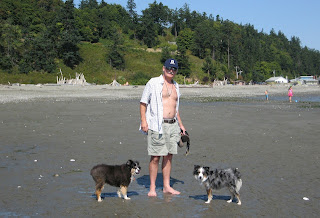It was an unbelievably intense show last night, the Fourth of July, and it had little to do with any fireworks. Mother Nature in the form of a severe monsoon storm gave us a stupendous, late afternoon drama.
The obvious clue was the dark clouds advancing from the east. Even so, we were not prepared for the powerful gusts of wind that swirled in every direction. Eucalyptus branches were flung onto saguaros where they clung to the spikes. Our classically beautiful blue agave flower spike, the proud subject of an earlier blog, is now lying down on the driveway, blown over by successive gusts. The enclosure I built for the vegetable garden, the proud subject of another earlier blog, got blown over on its side. We lost a clay pot, blown over. Bits and pieces of Aleppo pine everywhere, mostly in the pool.
The rain was unusually heavy. Then we realized that the bouncing rain drops were really pieces of hail -- Ice falling from the sky. In the thick of the storm, we thought we'd look out the back door. It was like opening a hatch in a submerged submarine: nothing but water coming in sideways. We leaned into the door and shut it.

The driveway was completely flooded. The little swale to the west, hardly a couple of hundred feet long, had a torrent of water.
 |
| Staring at the Storm. |

For some reason unknown to us from Puget Sound, houses in Tucson are not designed with rain in mind. Our backyard, all covered in concrete and paving bricks, slopes towards the house. The four doors that open into the backyard are exactly at ground level. With any decent amount of rain, two of the doors, by our TV room and the kitchen, flood immediately. Some years back I cut some 1x2 wood and glued them down with adhesive caulk to form dams outside these two doors. When it rains hard, I am out there with my shop broom sweeping water away from the house. Actually, it's kinda fun, if a little humid.
I like to joke that if you don't like the weather here, wait a couple of hours. The storm blew over and it became eerily quiet, with beautiful reddish light as the sun descended lower and lower.
Guests began arriving for our Fourth of July outdoor extravaganza. It was no small act of courage to get here, driving around flooded streets. But we have good friends, and we all enjoyed sitting outside enjoying the cooled, damp air. The desert smells wonderful in the rain.
 |
Fireworks on A-Mountain pale in
comparison to the divine lightning,
thunder, wind, hail, flying debris
and awakened critter show. |
People had been worried about fireworks starting fires in the tinder dry desert. That turned out to be not a problem. But fireworks were a little scaled down. We got some more rain - the drizzle-drop kind that Puget Sounders are all too familiar with - during the show. But it was the sound of a baby animal crying that interested us. What was that noise?
Armed with flashlights, we looked around the goldfish pond and discovered two frogs. Where do these guys come from? It's amazing here in the desert. One good rainfall and critters you haven't seen in a year come out of nowhere. One frog was making all that noise.

The odd crying-croaking noise continued off and on throughout the night. By morning there were frog eggs deposited in various places around the swimming pool. I could find none in the pond. Did the goldfish eat them? Their bellies were pretty big this morning. Or do frogs prefer chlorinated water for their "act"?
Shari got up first this morning. She used the net to pull four frogs out of the swimming pool and deposit them on the other side of the wall. An hour later, I found another five in the pool. They are well camouflaged. Some looked dead, belly up on the swimming pool bottom. But a few minutes after shaking them from the net outside the wall, they start reviving.
So much clean-up left. It's hopeless to think about raising the blue agave stalk. Garbage cans are already stuffed with yard waste, made even heavier with rainwater. It will take many hours for the kreepy krawler to suck the fine debris off the pool bottom.
A rain gauge a little up the hill registered an inch and a quarter. (Check out http://rainlog.org/usprn/html/main/maps.jsp) Down by the Rillito River, gauges registered a half and inch to an inch. All weather here is very local. Go a few hundred yards and the rainfall will differ greatly. I reckon we got about an inch, judging from the increased level in the swimming pool and subtracting some for the debris and frogs floating and sunk in it.
The forecast is for monsoon rains each afternoon this week. I have to charge my camera batteries.



















































